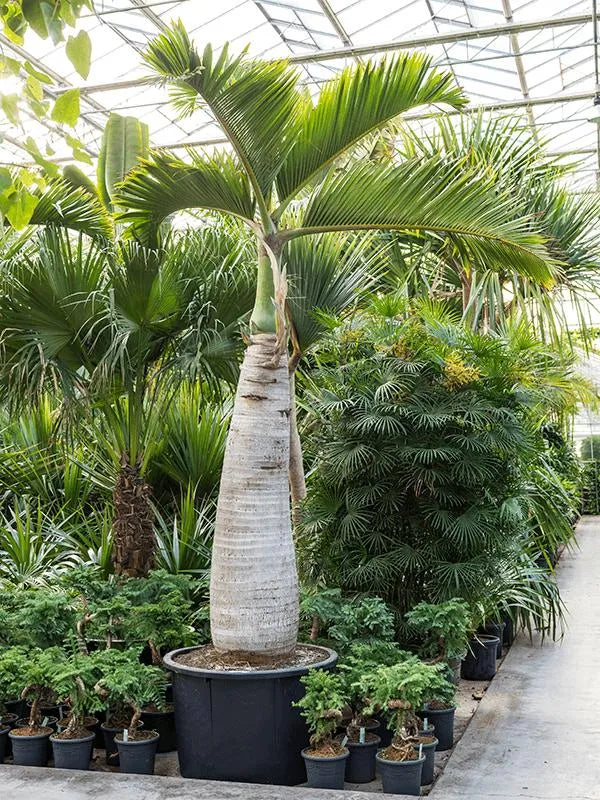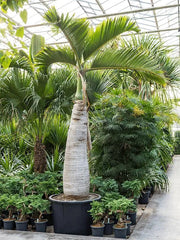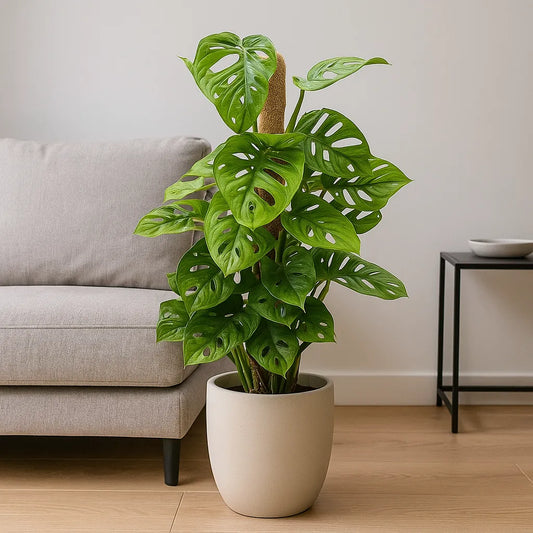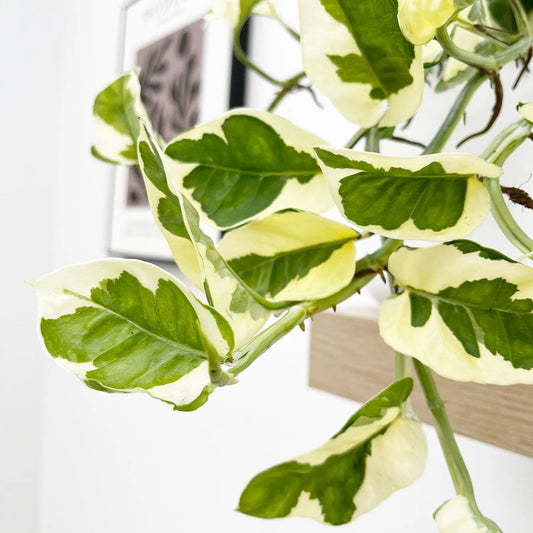

500 - 550cm Hyophorbe lagenicaulis XXL 120cm Pot House Plant
- £10,000.00
- £10,000.00
- Unit price
- per
Live Delivery Guarantee
At Plants for all Seasons, we stand behind the quality and vitality of every plant we deliver, which is why we proudly offer a Live Delivery Guarantee. This commitment means that we guarantee your plants will arrive at your doorstep in healthy, thriving condition. We understand the importance of receiving your plants in the best possible state, ready to enhance your space from the moment they arrive. With Plants for all Seasons's Live Delivery Guarantee, you can shop with complete peace of mind, knowing that your green investments are protected from our nursery to your doorstep.
30 Days Returns
Due to the sensitive and breakable nature of our products, it's understandable that damages may occur despite our meticulous packaging methods. If you find that your plant or pot has arrived in a less than satisfactory condition, please reach out to us at hello@plantsforallseasons.co.uk within a month of your delivery date. When contacting us, please provide your order reference, alongside a photo clearly showing the damaged item and its packaging, including the delivery label. We are committed to resolving such issues by offering a refund or a replacement, depending on the availability of the item in question.
We are unable to accept returns that are not related to damage because plants are inherently perishable and delicate. It's also worth noting that the plant you receive may slightly differ from the images displayed on our website. This variation is natural, given that each plant is unique and subject to seasonal growth changes.
Safe and Secure Delivery
At Plants for all Seasons, we recognise the critical role our courier partners play in ensuring the safe and secure delivery of your plants. We collaborate exclusively with leading courier services, renowned for their reliability and exceptional handling practices, to ensure your plants arrive in perfect condition. Our partners are carefully selected based on their commitment to timely deliveries and their proven track record in transporting delicate items with the utmost care.
Bespoke Eco Packaging
At Plants for all Seasons, our commitment to the environment extends to every aspect of our operations, especially in how we deliver your plants. We take pride in our bespoke, eco-friendly packaging, meticulously designed for the safe transport of live plants. Our innovative packaging solutions are crafted from sustainable materials, ensuring that your plants are not only secure but also that their journey from our nursery to your home treads lightly on the earth. This thoughtful approach minimises stress on the plants and reduces waste, aligning with our mission to promote a greener, more sustainable future.
Delivered within 2-3 working days
£6.99 for DHL next day service. Pay one delivery fee for any amount of plants & accessories.
🌴 Hyophorbe lagenicaulis
Hyophorbe lagenicaulis, commonly known as the Bottle Palm, is an extraordinary tropical palm from Mauritius, celebrated for its distinctive bulbous, bottle-shaped trunk and elegantly arching fronds. The thickened base acts as a water reservoir, giving the plant its iconic silhouette and excellent drought tolerance once mature.
It is a slow-growing palm, typically forming a single grey trunk that swells near the base and narrows towards the crown. The foliage consists of 4–6 long, feather-like fronds with leaflets that curve gracefully downwards, creating a poised and tropical look. In its native climate, the Bottle Palm may reach 3–4 metres, but in containers or cooler climates it remains much smaller and compact – perfect for conservatories, heated greenhouses, or tropical-themed interiors.
This rare and striking species makes a bold architectural statement, valued both for its sculptural form and exotic appeal.
🛠️ Hyophorbe lagenicaulis – Comprehensive Care Guide
🌞 Light Requirements
-
Requires bright, indirect light to full sun.
-
Indoors: best placed in a sunny conservatory or near a south- or west-facing window.
-
Outdoors in summer: can be placed in a sunny, sheltered patio.
-
Avoid deep shade – inadequate light will reduce frond production and slow growth.
💧 Watering
-
Keep soil moderately moist, especially during the growing season (spring and summer).
-
Water when the top 3–5cm of soil feels dry.
-
In winter, reduce watering to every 2–3 weeks, ensuring the plant never sits in soggy soil.
-
The swollen trunk provides some water storage – overwatering is a greater risk than underwatering.
🌫️ Humidity
-
Prefers moderate to high humidity (50–70%).
-
In dry indoor air (especially in winter), increase humidity by:
-
Using a humidifier,
-
Placing a pebble tray with water beneath the pot,
-
Light misting around the foliage – avoid wetting the crown directly.
-
🌡️ Temperature
-
Thrives in warm temperatures: 18–30°C ideal.
-
Very frost-sensitive – never expose to temperatures below 10°C.
-
Must be overwintered indoors in the UK – a heated greenhouse or conservatory is best.
-
Protect from cold draughts and sudden temperature drops.
🌱 Soil
-
Requires free-draining, sandy or gritty soil.
-
Best in a mix of:
-
2 parts loam-based houseplant compost,
-
1 part coarse sand or perlite,
-
1 part orchid bark or horticultural grit.
-
-
Drainage holes are essential to prevent root rot.
🍽️ Feeding
-
Feed every 4–6 weeks in spring and summer with a balanced palm fertiliser.
-
Reduce feeding in autumn and do not feed in winter.
-
A trace element-rich feed (with magnesium and manganese) will help maintain leaf colour and prevent frond yellowing.
✂️ Pruning & Maintenance
-
Minimal pruning required.
-
Remove fully dead or damaged fronds at the base using clean secateurs.
-
Never prune green fronds or the central spear – damage here can be fatal, as palms grow from a single terminal bud.
🪴 Repotting
-
Repot every 2–3 years, or when rootbound.
-
Use a deep pot with a wide base to accommodate the swollen caudex.
-
Repot in spring for best results.
🐛 Pests & Problems
-
Generally pest-resistant, but may occasionally attract:
-
Spider mites or mealybugs in dry indoor conditions,
-
Scale insects on undersides of fronds.
-
-
Frond yellowing can indicate:
-
Overwatering,
-
Nutrient deficiency (especially magnesium),
-
Cold exposure.
-
☠️ Toxicity
-
Not known to be toxic to humans or pets.
-
Always supervise pets around rare or valuable tropical specimens.
🌟 Top Tips for Success
-
Perfect for indoor palm lovers who want something unusual and sculptural.
-
Grow in a large, decorative container to highlight its elegant form.
-
Combine with ferns, Alocasias, and other warm-climate tropicals for a lush display.
Upright and Fresh: Our innovative design ensures that your plants remain upright and fresh during transit. Specially engineered compartments and supports within the box prevent movement and damage, so your plants arrive in perfect condition.
100% Recyclable: Our plant boxes are fully recyclable, ensuring that after they have served their purpose, they can be responsibly disposed of without harming the planet.
Made from Recycled Materials: Sustainability is at the core of our values. That’s why our packaging is crafted from recycled materials, reducing waste and promoting a circular economy.
Winter Shipping: We offer additional heat packs in winter to keep your plants nice and warm on their travels. Add one heat pack per plant when checking out in winter months.
By choosing our products, you are not only enhancing your home with beautiful plants but also contributing to a greener, more sustainable future
Check out our YouTube video to see exactly how we pack for safe delivery.
Plastic Nursery Pots: All our plants are supplied in practical plastic nursery pots. If you prefer a more decorative option, we offer a range of stylish pots available for purchase separately.
Non-Consumable: Please note that our plants are intended for ornamental purposes only unless specifically stated as edible. Ensure you check product descriptions carefully if you are looking for edible varieties.
Variable Heights: The height of our plants can vary by approximately +/- 10%. This natural fluctuation ensures you receive a unique and healthy specimen.
Plant Pot Sizes: Pot sizes may vary by approximately +/- 1cm. To ensure a proper fit, we recommend selecting a decorative pot that is 1-2cm larger than the stated plant pot size. For instance, if you purchase a plant in a 17cm pot, a 18 - 19cm decorative pot would be ideal.
Quarantining: All our houseplants are regularly sprayed with a preventative systemic bug treatment. We do our best to ensure a bug free growing environment however sometimes these can unfortunately be missed, as such we always recommend quarantining plants when they first enter your home and checking them upon arrival for bugs.
New In Stock
View all New In Stock- Choosing a selection results in a full page refresh.











